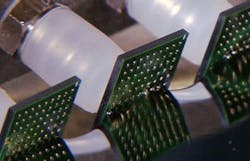Why component preparation matters in aerospace and defense systems
FARNBOROUGH, England – One of the several conversations I had at the Farnborough International Show,was with Don Tyler, President and CEO, Corfin Industries, a company that provides component preparation services to industries including defense, aerospace, medical, telecommunications, and transportation.
One of the main focuses of the company is converting lead-free components to tin-lead (SnPb). At Corfin Industries, business is healthy, with three main drivers factoring in:
"The ever-increasing recognition of lead free risks and the intolerances of them is the first reason," said Tyler. "Tin whisker growth and weak solder joints that can’t handle the abusive environments of high-reliability systems present significant risks. Second, the decreasing availability of tin lead options direct from manufacturers of components is a driver for us as well."
He added, "Third, the increasing demand in components needed to satisfy functional demands of modern systems (the Joint Strike Fighter program, for example)," he said. "Electronics are smaller, faster, and better, which help enable this."
Tin whiskers, which can spring up from components not made from tin-lead, can cause short circuits, low pressure arcing, and debris and contamination. In mission-critical systems, these are unacceptable. This is why Corfin Industries converts components to tin-lead.
Looking at the industry overall, Tyler provided an outlook that bodes well for both Corfin Industries and the wider defense aviation industry on the whole.
"There is [U.S.] defense budget growth, and NATO budget increases, which are a positive sign for us and for the industry," he said.
In terms of what is new with Corfin Industries, the company is now compliant with IEC TS 62647-4, which defines the requirements for replacing solder balls on ball grid array component packages in the context of an electronic components management plan for aerospace, defense, and high reliability products.
"This," suggests Tyler, "helps justify to high-reliability markets that there is an industry-wide acceptance of Corfin Industries’ process for these complex components."
As business has been good for Corfin Industries as of late, the company has been striving to find new ways to increase capacity while maintaining quality, in order to meet the increased demand for the company’s services, explains Tyler. To do so, Corfin Industries has deployed robotic systems that utilize machine vision in order to inspect components in an efficient and effective manner.
"We are now developing methods to speed up cycle times and to process as many parts as we can with our robot systems," he said.
View more information on Corfin Industries.
